The NAPPC Honey Bee Health Task Force
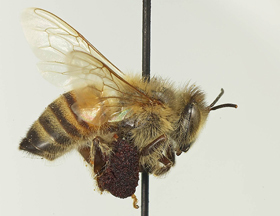
The North American Pollinator Protection Campaign (NAPPC) is a collaborative group of scientists, government agencies, NGO’s, private industries and agricultural and environmental concerns that work together to bring the plight of pollinators to national attention and to be the most trusted resource for information and behaviors in support of pollinating animals and the plants with which they interact. NAPPC works for all species of pollinators across the whole of North America. NAPPC partners have formed specialist task forces to address all the issues that face pollinators, and one such group is the NAPPC Honey Bee Health Task Force.
The NAPPC Honey Bee Task Force has several functions, determining each year the recipients of honey bee health grants that have for the past twelve years supported research in honey bee genetics, pesticide exposure, nutrition, and management. In addition, the task force is dedicated to providing the latest findings and perspectives on honey bee health to the public, policy makers and the press. The following honey bee health issues have been provided by that task force. We hope you find them useful, and we welcome questions and comments to info@nappc.org.
Honey Bee Health
So much of our agricultural productivity is dependent on the European honey bee (Apis mellifera) that it is no wonder that our attention is drawn to their plight. When the honey bee suffers, so does agriculture, and so, potentially do all who depend on the bounty that comes from animal pollinated angiosperms, the flowering plants from which we derive many of our most delicious and health-giving fruits and vegetables.
While honey bees are clearly not the only hard working pollinators that deliver a bounty to humans and other animals, their recent deaths from Colony Collapse Disorder (CCD) starting in 2006 have captured the world’s attention. To date, CCD has been defined as a series of symptoms, but the cause and the cure have remained complex and elusive. CCD is not the only problem facing honey bees; in fact, in 2010 the overwintering losses were at the same unsustainable rates of over 30% but the cause seemed to be less from CCD than from other problems. Below is a list of the variety of issues facing honey bees.
The North American Pollinator Protection Campaign Scientists Report on Honey Bee Stressors
Parasites
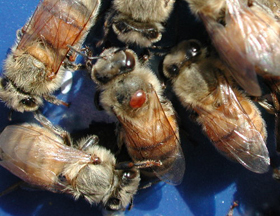
The Varroa mite (Varroa destructor)
Is an external parasite that has spread from its original host, the Asian honey bee Apis cerana, to nearly all Western honey bees (Apis mellifera) worldwide. Virtually all European honey bees are highly vulnerable to Varroa mites, although some honey bee strains (VSH, Russians) show partial resistance to the mites. This mite weakens honey bees by sucking hemolymph (“blood”) from its host and by transmitting bee pathogens. A female mite reproduces by invading the cell of a bee larva just before capping. Once inside, the female lays eggs to produce offspring that feed together on the developing bee. The mother mite and her adult daughters emerge from the cell with the young adult bee host. Eventually, at high infestation rates, the mites overwhelm and kill the host colony. Beekeepers control Varroa mite populations by monitoring mite infestation rates and applying chemical treatments when mite populations become too large. Due to increased concerns over the effects of miticides on bees and mite resistance to commercial miticides, researchers are developing alternative approaches (“softer” chemical treatments, the genetics of mite resistance in honey bees, mite pheromones and hormones, and physical treatments) to control this mite.
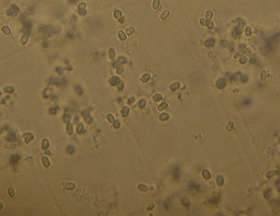
Nosema ceranae
This microscopic fungus can weaken or even kill colonies when the majority of workers become infected. Spores of the fungus survive on wax combs and stored food inside colonies. When workers eat these spores the fungus invades the lining of the intestine. Highly infected bees cannot digest efficiently and die earlier. Beekeepers use antibiotics and disinfection of hives to control this disease.
Viruses
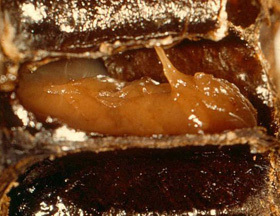
Thus far, more than 20 honey bee viruses have been identified. These viruses can impact bees in multiple ways, including killing developing larvae and pupae, decreasing the lifespan of adult bees, causing spasms and tremors, reducing cognitive skills, and impairing wing development so that bees cannot fly. Most honey bee colonies have multiple viruses, and the levels of these viruses can fluctuate throughout the year. Exposure to other stressors, particularly Varroa parasitization, can immunosuppress bees so that the effects of the viruses are more dramatic. The only treatment for viruses thus far is to feed the colony a solution of virus-specific RNA that enhances the bees' immune responses to these particular viruses, but these treatments only suppress the viral infections, and do not eradicate them. Other approaches that are being investigated include breeding bees with genetic resistance to the viruses.
Bacterial Diseases
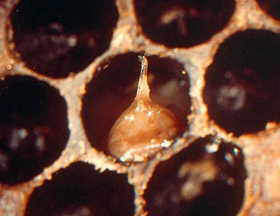
American foulbrood (Paenibacillus larvae)
American foulbrood is an infection that kills young bees (brood) inside the wax cells in which they develop. This dead brood becomes a source of infection spread by workers nursing young brood. Some bees can detect and remove the diseased brood and this stops the disease from spreading. Beekeepers also use antibiotics to prevent the disease.
Pesticides
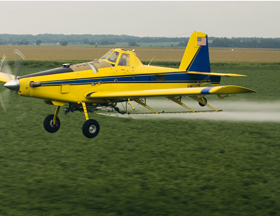
Pesticides are usually man made chemicals designed to kill pest organisms, that may injure plants or animals including humans. Pests cause economic damage by reducing crop yields directly or by producing crop, or ornamental plant diseases, or by competing with crops, or by reducing animal and human health, or by damaging buildings and structures. Pesticides are categorized according to their intended use as well as by their chemical composition. Pesticides are widely used and are divided into insecticides/acaricides, used to control insects and mites or ticks, fungicides used to control plant diseases; rodenticides, used to control rodents; and herbicides used to prevent weeds from competing with crops, grasses or ornamental plants. Pesticides usually contain an active ingredient, with a known mechanism for killing the target pests. Pesticides vary widely in their safety to humans and the environment and are sold as a formulation with added ingredients that augment the action of the active material when mixed in water for application. More than 1200 chemicals are registered for use in the United States and are used in some 18,000 separate products sold under a variety of trade names. People who apply the more toxic pesticides must have training and a state issued license to use these materials.
Some insecticides have warnings or bee hazards on their label because they are toxic to honey bees, causing honey bee deaths. If the insecticide has a sub-lethal affect on honey bees it may result in reduced larval survival, altered foraging behavior or shortened lifespan of adult bees. The extent of the sub-lethal affects is still unknown.
Click here to view a PDF list of recent published pesticide resources including recent work on neonicotinoids.
Nutrition
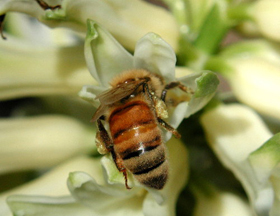
Honey bee colonies are healthier and stronger with access to pollen from diverse sources of flowering plants. However, floral diversity in landscapes has been reduced by intensive agriculture (single crops, few flowering weeds, limited hedgerows) and urbanization. In recent years, the pollination of early crops (such as almonds in California in February) has further increased the demand for strong colonies at times of year with few floral sources. Furthermore, changes in climate patterns may also affect seasonal availability of flowering plants. This requires beekeepers to use artificial sources (sugar syrup, corn syrup, and pollen substitutes) to try to meet the increased nutritional demands of their colonies.
Genetics
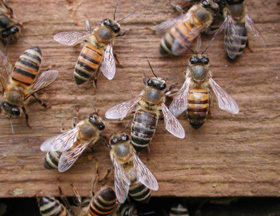
Honey bee colonies are headed by a single queen who mates with an average of 12 males, and thus honey bee colonies are extremely genetically diverse. Several studies have demonstrated that genetic diversity improves the disease resistance and productivity of colonies, including their overwintering ability. Furthermore, strains of honey bees can have different traits - some forage for more pollen, while others are more adept at hygienic behavior, in which diseased or parasitized brood is removed. Several breeding programs are underway to develop stocks of bees that are more resistant to diseases and parasites, are better at overwintering in specific climates, and are productive and gentle.
Queen Quality
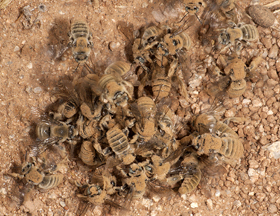
The honey bee queen is responsible for producing all the workers in the colony, and she lays up to 1500 eggs a day. Poor quality queens can severely impact colony health. Queens with low egg-laying capacity can limit the numbers of health workers produced, while unhealthy queens can die or be killed by workers, causing a break in brood rearing that again limits colony growth and productivity. Poor quality queens are consistently cited by beekeepers as a major factor underlying colony failure, and a longitudinal study of colonies indicated that loss of a queen or lack of laying by a queen was one of the two factors linked to colony loss. Several factors seems to impact queen quality, including rearing conditions and mating number.
Management
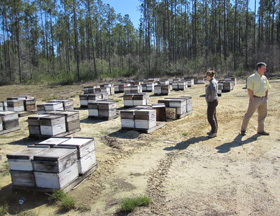
Proper management of honey bee colonies is a critical component of their health and productivity. Many of the stressors listed on this page can be mitigated by using the proper techniques. Beekeepers need to place their colonies is appropriate locations, which allow access to adequate foraging sites and are distant from areas where pesticides are being applied (honey bees can forage up to 5 km away from their colonies). Beekeepers can provide supplementary nutrition, in the form of sucrose solution or protein patties, during periods of low nectar flow. Beekeepers can monitor for pests, such as Varroa mites and Nosema microporidia, and use chemical or non-chemical methods to control these as needed. Beekeepers can minimize exposure to pathogens, such as viruses and bacteria, by systematically replacing used brood comb with fresh comb. Using genetic stocks of bees that more resistant to pests and pathogens is also an excellent way to reduce complications from these two stressors. Finally, rapid supercedure of poor quality queen honey bees can lead to colony losses, and thus purchasing queens from excellent sources or rearing queens locally can improve colony productivity and health. For more information, please see the Honey Bee Best Management Practices guide that has been developed by the Managed Pollinator Coordinated Agriculture Program (CAP) and Project Apis m (PAm).
Reviews on Honey Bee Health
The Plight of Bees- Environmental Science and Technology Dennis vanEngelsdorp, Marina Doris Meixner A historical review of managed honey bee populations in Europe and the United States and the factors that may affect them. Journal of Invertebrate Pathology 103 (2010) S80–S95 Solving the Mystery of the Vanishing Bees- Scientific American: April 40-47. Nosema ceranae The Inside Story Nosema Microsporidia: Friend Foe and Intriguing Creatures Higes M, Martín-Hernández R, Botías,C, Garrido-Bailón E, González-Porto AV, Barrios L, del Nozal MJ, Bernal JL, Jiménez, JJ, García-Palencia, P, Meana, A. 2008 Honey Bee Disorders: Bacterial Diseases Honey Bee Nutrition USDA 2011 Colony Collapse Disorder Annual Report
USDA and EPA Release New Report on Honey Bee Health - Release Date: 05/02/2013
UNEP Emerging Issue: Honey Bee Colony Disorders and Other Threats to Insect Pollinators
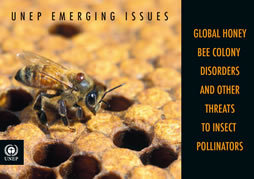
Download this PDF to learn more about global Honey Bee colony disorders and other threats to insect pollinators.
"Introduction
Current evidence demonstrates that a sixth major extinction of biological diversity event is underway.1. The Earth is losing between one and ten percent of biodiversity per decade2, mostly due to habitat loss, pest invasion, pollution, over-harvesting and disease3. Certain natural ecosystem services are vital for human societies. Many fruit, nut, vegetable, legume, and seed crops depend on pollination. Pollination services are provided both by wild, free-living organisms (mainly bees, but also to name a few many butterflies, moths and flies), and by commercially managed bee species. Bees are the predominant and most economically important group of pollinators in most geographical regions. The Food and Agriculture Organisation of the United Nations (FAO)4 estimates that out of some 100 crop species which provide 90% of food worldwide, 71 of these are bee-pollinated. In Europe alone, 84% of the 264 crop species are animalpollinated and 4 000 vegetable varieties exist thanks to pollination by bees 5. The production value of one tonne of pollinator-dependent crop is approximately five times higher than one of those crop categories that do not depend on insects. Has a “pollinator crisis” really been occurring during recent decades, or are these concerns just another sign of global biodiversity decline? Several studies have highlighted different factors leading to the pollinators’ decline that have been observed around the world. This bulletin considers the latest scientific findings and analyses possible answers to this question. As the bee group is the most important pollinator worldwide, this bulletin focuses on the instability of wild and managed bee populations."
Excerpts from the PDF
Honey Bee and Wild Bee Interaction
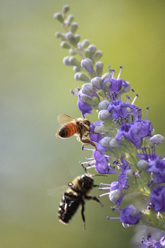
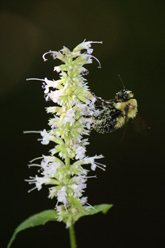
Honey Bee and Wild Bee Interaction
Updated April 2, 2012 – www.pollinator.org
The following list of peer reviewed publications has been generated by members of the pollinator LISTSERV. Some of these studies report tests of native bee/honey bee interactions, others provide background and insight into potential interactions. If you have an additional study to add to this list please email info@pollinator.org. We are also in the process of developing a new 2012 NAPPC Task Force that will take on this issue. If you are interested in chairing or participating in this task force please contact Vicki Wojcik, vw@pollinator.org.
Peer Reviewed Publications
- Aizen MA and Feinsinger P (1994) Habitat Fragmentation, Native Insect Pollinators, and Feral Honey Bees in Argentine 'Chaco Serrano'. Ecological Applications 4(2) 378-392
- Badan EI and Vergara CH (2011) Potential negative effects of exotic honey bees on the diversity of native pollinators and yield of highland coffee plantations. Agricultural and Forest Entomology 13:365–372
- Burkle LA and R. Alarcón (2011)The future of plant – pollinator diversity: understanding interaction networks across time, space, and global change. American Journal of Botany 98(3): 528–538.
- Cairns CE, Villanueva-Gutiérrez R, Koptur S, Bray DB (2005) Bee populations, forest disturbance, and africanization in Mexico. Biotropica 37 (4):686-692.
- Dohzono I and Yokoyama J (2010) Impacts of alien bees on native plant-pollinator relationships: A review with special emphasis on plant reproduction. Applied Entomology and Zoology 45:37-47.
- Eickwort GC and Ginsberg HS (1980) Foraging and mating behavior in Apoidea. Ann. Rev. Entomol. 25:421-46
- Ginsberg HS (1981) Historical development of bee foraging patterns in central new york state Psyche 88:337-346
- Ginsburg HS (1983) Foraging ecology of bees in an old field. Ecology 64: 165-175.
- Goulson D (2003) Effects of introduced bees on native ecosystems. Annual Review of Ecology, Evolution, and Systematics 34: 1-26.
- Goulson D, J C Stout, A R Kells Journal of Insect Conservation (2002) Do exotic bumblebees and honeybees compete with native flower-visiting insects in Tasmania ? Journal of Insect Conservation 6(3): 179-189
- Knowles D (1983/4) Flying jewels. Geo 5:46-57
- Kremen C, Williams NM, Thorp RW (2002) Crop pollination from native bees at risk from agricultural intensification. PNAS 99 (26) 16812–16816.
- National Research Council of the National Academies (2006). Status of Pollinators in North America. National Academy Press, Washington, DC.
- Paton DC (1985) Food supply, population structure, and behaviour of New Holland honeyeaters Phylidonyris novaehollandiae in woodlands near Horsham, Victoria. Pages 222-230 in Keats, A, et al, eds. Birds of eucalypt forests and woodlands: ecology, conservation and management. Sydney (Australia): Royal Australian Ornithologists Union and Surrey Beatty and Sons.
- Paton DC (1993) Honeybees in the Australian environment. Bio Science 43: 95-103
- Pearson J FW. (1933) Studies on the ecological relations of bees in the Chicago region. Ecol. Monogr. 3:375-441.
- Potts, SG, JC Biesmeijer, C Kremen, P Neumann, Oliver Schweiger and WE Kunin. (2010) Global pollinator declines: trends, impacts and drivers. Trends in Ecology and Evolution 25 (6) 345-355.
- Pyke GH and Balzer L (1985) The effects of the introduced honey bee (Apis mellifera) on Australian native bees. Occasional paper nr 7. Sydney (Australia): New South Wales National Prks Wildlife Service.
- Roubik DW and Villanueva-Gutiérrez, R (2009) Invasive Africanized honey bee impact on native solitary bees: a pollen resource and trap nest analysis. Biological Journal of the Linnean Society 98: 152-160.
- Roubik DW, Moreno E, Vergara C, Wittmann D (1986) Sporadic food competition with the African honey bee: projected impact on neotropical social bees. Journal of Tropical Ecology 2: 97-111.
- Roubik, DW and H Wolda (2001) Do competing honey bees matter? Dynamics and abundance of native bees before and after honey bee invasion. Popul Ecol 43:53–62
- Sáez A, Sabatino M, and Aizen MA (2012) Interactive Effects of Large- and Small-Scale Sources of Feral Honey-Bees for Sunflower in the Argentine Pampas PLoS One 7(1): e30968.
- Schaffer WM, Jensen DB, Hobbs DE, Gurevitch J, Todd JR and M. Schaffer V (1979) Competition, foraging energetics and the cost of sociality in three species of bees. Ecology 60: 976-987.
- Steffan-Dewenter I and Tscharntke T (2000) Resource Overlap and Possible Competition between Honey Bees and Wild Bees in Central Europe. Oecologia 122(2):288-296
- Stout JC and Morales Cl (2009) Ecological impacts of invasive alien species on bees. Apidologie 40: 388-409.
- Sugden EA and Pyke, GH (1991) Effects of honey bees on colonies of Exoneura asimillima, an Australian native bee. Australian Journal of Ecology 16: 171-181.
- Thomson DM (2004) Competitive interactions between the invasive european honey bee and native bumble bees. Ecology 85(2):458–470
- Thomson DM (2006) Detecting the effects of introduced species: a case study of competition between Apis and Bombus. OIKOS 114: 407-418
- Villanueva-Gutiérrez R, Roubik, DW, Colli-Ucán W(2005) Extinction of Melipona beecheii and traditional beekeeping in the Yucatán peninsula. Bee World 86 (2): 35-41
- Wenner AM, Thorp RW and Barthell JF. Removal of european honey bees from the Santa cruz island ecosystem. Pages 327–335 in Damiani, C.C. and D.K. Garcelon (eds.). 2009. Proceedings of 327 the 7th California Islands Symposium. Institute for Wildlife Studies, Arcata, CA.
- William M. Schaffer WM, DW. Zeh, SL Buchmann, S Kleinhans, MV Schaffer and J Antrim (1983) Competition for Nectar between Introduced Honey Bees and Native North American Bees and Ants Ecology 64(3): 564-577
Reports and other resources
- Morkeski A and Averill AL (2010) Wild Bee Status and Evidence for Pathogen Spillover with Honey Bees CAP Updates: 12: https://bee-health.extension.org/wild-bee-status-and-evidence-for-pathogen-spillover-with-honey-bees/
- Thorp RW, Wenner AM and Barthell JF (1999) Pollen and nectar resource overlap among bees on Santa Cruz Island, click here to view.
Honey Bee Life Cycles
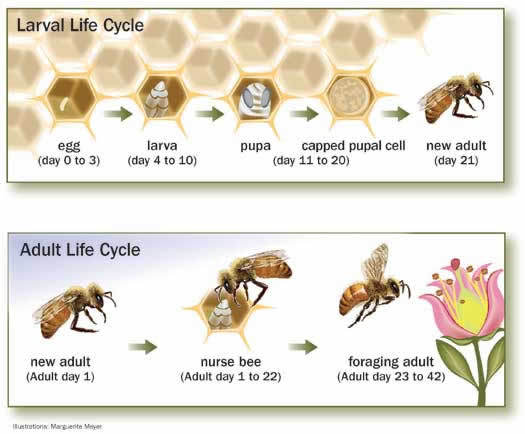
Individual Worker Honey Bee Life Cycle The entire bee hive has an annual cycle from spring to fall, with a less active winter phase. Individual bee life cycles occur throughout this colony cycle. It takes more than 20 days for an egg to develop into a worker bee. Once hatched, each worker bee lives for about 40 days. Half of a bee’s life is spent in the hive working, the other half is spent outside of the hive foraging.
Larval Worker Honey Bee Life Cycle The queen bee lays an egg into an empty cell – this is different than solitary bees that lay their eggs on a pollen ball. The egg hatches into a larva that is fed by worker nurse bees. After about 5-6 days the larva will turn into a pupa. Nurse bees put a cap on the cell once there is a pupa to protect the developing adult. After about 10-12 days the pupa will emerge. Temperature plays a big role in how insects develop. This is why the number of days from egg to larva to pupa to adult can vary slightly.
Adult Worker Honey Bee Life Cycle After the adult emerges she beings take on tasks in the hive. She spends the first few days cleaning cells (day 1 and 2), then she takes on the role of nurse (day 3 to 11) where she feeds developing larvae. After feeding duty she works to cap cells with wax that she produces (day 12-17). Her final days working in the hive are spent guarding the front entrance (day 18-21). After about three weeks in the hive she transitions to the role of forager and goes out to collect food for the colony (23 days and beyond).
The total worker bee life span from laid egg to the death of the adult averages 7 to 9 weeks. It takes 3 weeks for the egg to develop into a worker adult. The adult then lives for 4 to 6 weeks. Some worker bees that are produced in the fall live longer than 9 weeks because they spend the winter in the hive and have early foraging duties in the spring.
Solitary Bee Life Cycle
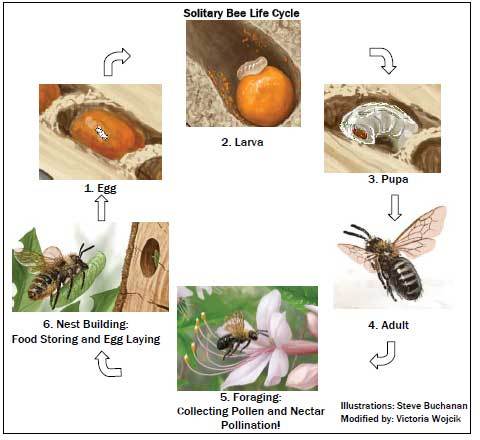
Individual Solitary Bee Life Cycle
- An egg is laid by a female solitary bee on top of a pollen ball.
- After a few days the egg will hatch and become a larva that quickly eats the food source left by the female.
- The larva grows and eventually becomes a pupa. The pupa is the transformation stage when cells in the body rearrange and mature and the bee starts to look like the adult bees we are familiar seeing. The pupa hatches from its case and then emerges from the nest by chewing its way through leaves or mud.
- An adult bee emerges from the nest! This bee then mates and the cycle is ready to start all over again.
- Once a female has mated she works all day foraging, visiting flowers collecting pollen and nectar that she will use to build pollen balls. A female solitary bee makes 15–20 flower visits to complete just one cell in a nest. Pollination occurs as the female bumps into the flower’s anthers and stigma during these visits.
- Once a female has built all of her cells in one nest she seals off the end and leaves to start another nest.
Colony Life Cycle
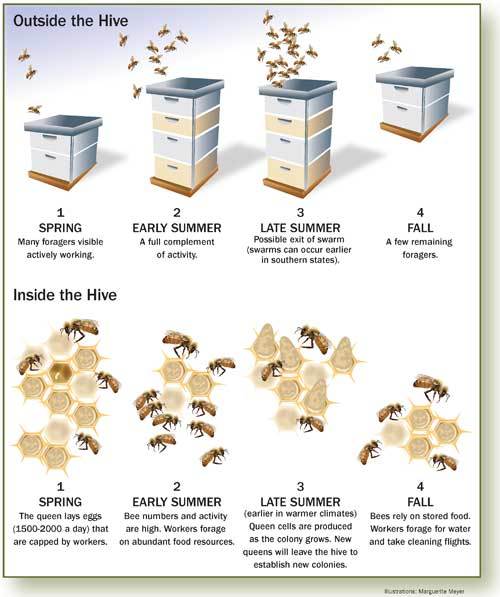
COLONY CYCLE (see illustrations to the right) Winter (not shown) A bee hive has a season cycle that repeats from year to year. During the winter a hive is dormant. The bees in the colony surround the queen and keep her warm. The colony survives the winter by feeding off of honey stores that were collected the previous year.
Spring (1) When the weather gets warmer and spring flowers start to bloom the colony becomes more active (1). Overwintering foragers leave the hive to collect pollen and nectar; the queen has been laying eggs (between 1500 to 2000 each day) and the colony is ready for spring.
Summer (2 and 3) In early summer (2) the colony is very active. Foragers leave daily to collect pollen and nectar and many new worker bees emerge. By late summer the colony has grown very large and strong (3). Workers start to produce new queen cells that will produce new queen bees (in warmer climates this can occur earlier in the spring as well). After the new queens hatch, they leave the colony, each taking some worker bees with them. This is called swarming.
Fall (4) By the fall (4) the flowers have stopped blooming and are producing fruit. The colony works on storing food and foraging for nectar slows. Foragers look for water and take cleansing flights throughout the winter. The worker bees and the queen will spend the winter feeding off of their stored honey, waiting for the spring bloom of flowers.
Pollination in a Plant's Life Cycle
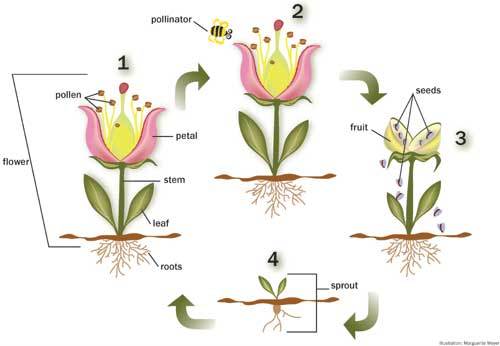
Pollinator Partnership's Perspective on Pesticides
Pollinator Partnership (P2) believes that the unwarranted use of all chemical pesticides (including insecticides like neonicotinoids, pyrethroids, carbamates, and organophosphates) must be eliminated. Read the full statement.